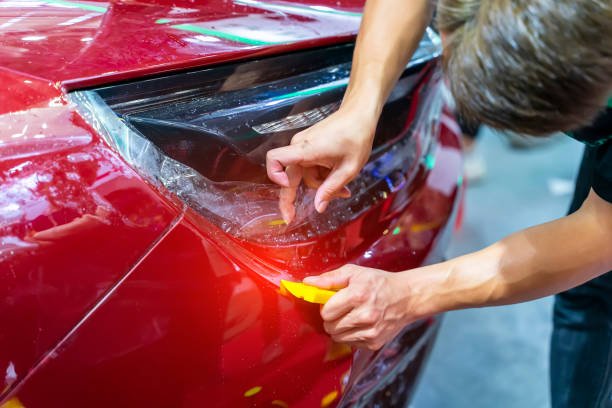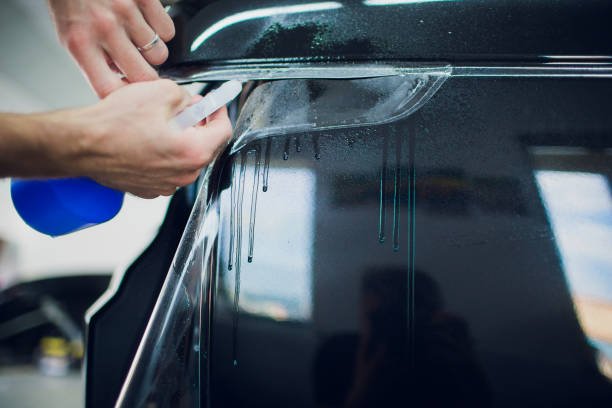1. Introduction
When it comes to automotive care, there is a section of enthusiasts who would prefer their vehicles to look clean at all times. However, waxing and regular paint jobs do have their limitations, but industry experts have come up with a more efficient alternative: Paint Protection Film (PPF). This is an ultra-thin and almost invisible layer of urethane that is said to aid in the prevention of scratches and chips, and in addition, guard against harmful UV rays, which can greatly assist in the preservation of your vehicle.
In this piece, we will look more into the PPF, the technique behind it, and its advantages to see if it is worth investing in for your vehicle, alongside various expert opinions and what awaits the future of PPF.
2. What is Paint Protection Film (PPF)?
Paint Protection Film is popularly known as PPF or a clear bra and is formed from a unique urethane layer which serves as a thin, tough, and transparent film. It acts as a shield for a car’s paint from external factors such as stone chips, scratches, and UV rays while ensuring that the original appearance of the car is still intact. Typically, the film is used in places where the impact is most likely to be, such as the bonnet or mirrors; however, it can be used all over the car as well to provide more protection.
PPF is an additional layer that is not noticeable; however, it is flexible, self-healing, and deflects elements, and therefore offers an enhanced level of coverage.
3. History of Paint Protection Film
The use of PPF can be traced back to the 1960s when soldiers would use a similar type of film to shield their helicopter blades from damage. Later, in the early 2000s, similar technologies were developed for use on vehicles and have improved their durability, self-healing properties, and enhanced clarity over time.
PPF use was originally limited to high-end vehicles, but in light of today’s technological advances and better lower-end options available in the market, everyday car owners can now use PPF to help maintain their vehicles.

4. How Does PPF Work?
PPF works by blocking the paint on a car from any incoming forces. The film, for example, would take the beating or force caused by small debris, and this in turn would prevent the car’s paint from scratching or chipping. PPF similarly blocks salt, tree sap, bird droppings, and anything else that would harm the paint.
One of the distinct characteristics of the PPF that stands out is the fact that it self-heals. Swirl marks and minor scratches vanish as if they were never there after being exposed to heat or sunlight, making the entire surface smooth and clear once again.
5. Benefits of Paint Protection Film
Enhanced Paint Protection
PPF, on the other hand, acts as a barrier protecting your vehicle against a vast range of damages consisting of stone chips, scratches, and even fading due to UV rays exposure.
Maintains Vehicle Appearance
Another cost advantage of PPF is that once it is installed, it helps in maintaining the car’s paint. This prevents it from corrosion for a long time, all while being invisible to the eye, so the original colour and design of the car do not get altered.
Easy Maintenance
Unlike wax, which needs to be reapplied every time it wears off, PPF does not require too much maintenance since it is also durable. Similar to how traditional wax operates, it just needs to be cleaned on occasion and requires a few touch-ups.
Increased Resale Value
For a car that has been well maintained and is free from visible dents and scratches, the resale prices are mostly higher. Thanks to PPF, vehicles remain as new as they did when they were on the showroom floor, hence increasing the resale value.
6. Types of Paint Protection Films
Gloss PPF
Of all the types of PPF available in the car wrapping market, gloss PPF is the most sought-after due to the fact that cars with it give off an appealing shiny glossy look without changing their colour.
Matte PPF
Those who admire a reflective-less look and own a matte-finished vehicle should go for the Matte PPF. It gives owners the best protection without being overly glossy.
Self-Healing PPF
Thanks to proprietary PPF technology, the PPF film can recover itself from mild scratches and swirl marks. This is unique as it keeps the film from losing its pristine and smooth finish.
Textured PPF
Textured PPF is not rumpled but is created with a slightly dimpled surface, which simulates the texture and feel of the paint of the car which makes it useful in providing extra protection for wheel arches and bumpers.
7. Is PPF Worth the Investment?
There will be a large amount that will go into the investment for PPF initially, but as owners have expressed, it proves to be a wise decision. With depreciation being taken into consideration, the film assists in getting through the hurdles of outrageous scratches, making touch-ups and repairs a cheap endeavour. Furthermore, a raw, unblemished PPF layer acts as a shield for the paint and heightens the resale value of the vehicle.
If the intention is to drive the car for extensive periods and still have it retain its initial appeal, then, expensive as it may seem at the beginning, it tends to be economical consistently as one reaches the concluding years.

8. Paint Protection Film vs. Ceramic Coating
Most car enthusiasts cannot decide between PPF and ceramic as there are overlaps in the two, but differences remain apparent as well.
- PPF is better suited for protecting one from physical damage such as chips and scratches.
- Ceramic coating offers a hydrophobic layer, but it lacks protection from impacts.
For the best protection, several car enthusiasts prefer to use both methods: applying the PPF over areas of the car that are likely to suffer impacts whilst applying the ceramic coating on the rest of the vehicle.
9. How to Apply Paint Protection Film
Preparation
Before applying PPF, the surface must be clean and devoid of contaminants. Washing and clay bar treatment of the surface are crucial steps towards achieving this.
Application
With the right tools and experience, a professional or an experienced do-it-yourself person is able to apply PPF over the surface while ensuring that air bubbles do not form under the film.
Curing
Immediately after applying, the film needs to be left undisturbed for 24-48 hours so that maximum bonding between the film and the vehicle’s paint can be achieved.
10. DIY vs Professional PPF Installation
DIY Installation
It is possible to install PPF by oneself, but the process is tricky and tedious. An air bubble or a misaligned application may be the result of improper applications. Some kits can be bought for DIY applications, but they will not have the same outcome as a professional installation.
Professional Installation
PPF has the best results when applied by people who are trained in the field and have the necessary equipment. The film can fit perfectly and has no flaws during a professional installation.
11. PPF Maintenance: How to Care for Your Film
Maintaining PPF is easy. Avoiding strong chemicals and exposing the film to extreme weather conditions helps with the duration of the film. Moreover, a lot of heat from elements such as the sun or a hot wash eradicates small imperfections on certain self-healing films.
12. Common Myths About PPF

PPF is Invisible
PPF is meant to be clear; however, some cheaper films may start to develop a yellow tint over time. For dependable results, consumers are advised to buy high-quality PPF.
PPF is a One-Time Investment
PPF should be replaced after a couple of years, but this varies on wear and tear. With proper maintenance, it can be used for longer periods.
13. Expert Insights on PPF
According to automotive experts, PPF technology is continuously evolving, with newer films offering even better self-healing capabilities, UV protection, and environmental resistance. As more car owners become aware of PPF’s benefits, demand is expected to grow, and innovations in the field will only continue to improve.
14. The Future of Paint Protection Film
The prospects for PPF appear to be very good indeed and car makers are looking at ways of producing thinner and stronger films which will improve overall protection without affecting vision. Also, the green PPF is already forming, these enable car owners to protect their needs without adding on more carbon footprint.
15. Conclusion
All in all, Paint Protection Film is an amazing product and every vehicle should have it installed as it provides as much protection as possible against scratches, chips and any deformations that may happen to a vehicle’s body. Car enthusiasts and those who seek to keep a car’s value intact will find PPF a worthy investment. New developments pave the way for PPF, which can in future give even better protection and more possibilities for customisation.
FAQ’s
[saswp_tiny_multiple_faq headline-0=”h3″ question-0=”How long does Paint Protection Film last?” answer-0=”High-quality PPF can last between 5 to 10 years, depending on the brand, environmental conditions, and maintenance practices. Regular cleaning and care can extend its lifespan. ” image-0=”” headline-1=”h3″ question-1=”Can PPF be removed without damaging the paint?” answer-1=”Yes, PPF can be safely removed without harming your vehicle’s paint. However, it’s recommended to have it removed by a professional to avoid adhesive residue or damage. ” image-1=”” headline-2=”h3″ question-2=”Does PPF change the appearance of the car’s paint?” answer-2=”No, PPF is designed to be nearly invisible, maintaining the original look of your car. Options like gloss or matte PPF can enhance specific finishes without altering the paint color. ” image-2=”” headline-3=”h3″ question-3=”Is Paint Protection Film worth it for older vehicles?” answer-3=”While PPF is commonly applied to new vehicles, it can also be beneficial for older cars to prevent further paint damage and maintain their appearance. Proper preparation of the paint surface is essential before application. ” image-3=”” headline-4=”h3″ question-4=”Can PPF protect against all types of damage?” answer-4=”PPF offers excellent protection against minor scratches, chips, and environmental damage, but it cannot prevent severe damage from large impacts or accidents. Combining PPF with other protective measures, like ceramic coating, enhances overall durability.” image-4=”” count=”5″ html=”true”]

1 thought on “The Ultimate Guide to Paint Protection Film (PPF): Benefits & Installation Tips”